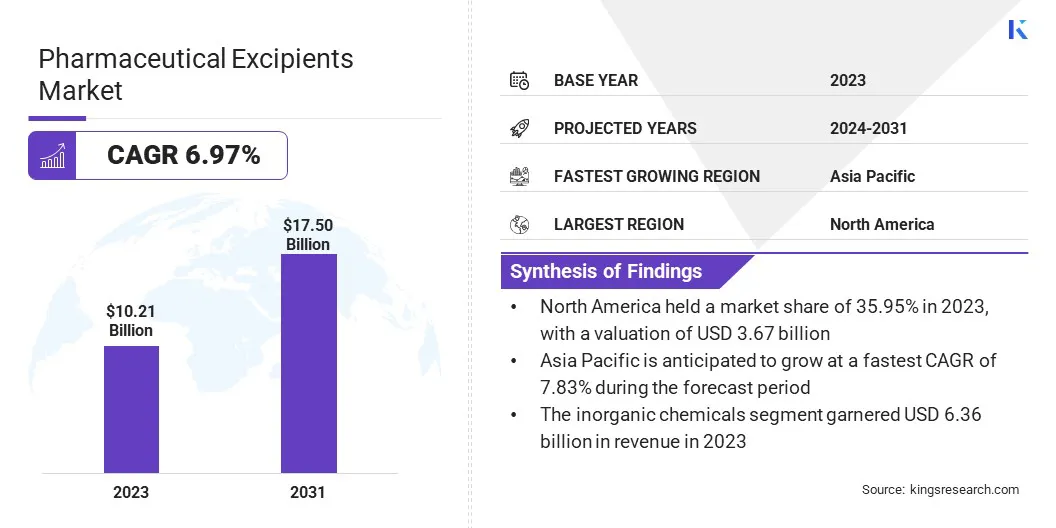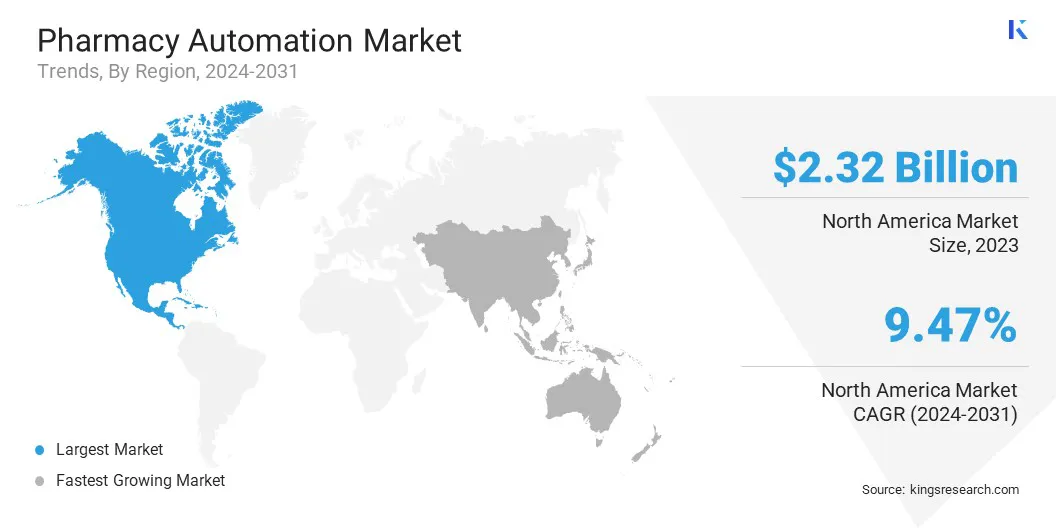Market Definition
The market comprises technologies designed to optimize medication distribution, packaging, verification, and storage in healthcare settings. It covers robotic systems for drug handling, automated blister and pouch packagers, barcode-based identification tools, modular storage units, and digital platforms for real-time stock tracking and operational coordination.
These solutions enhance accuracy, improve efficiency, and reduce reliance on manual processes in hospitals, retail pharmacies, and long-term care facilities. The report provides a comprehensive analysis of key drivers, emerging trends, and the competitive landscape expected to influence the market over the forecast period.
Pharmacy Automation Market Overview
The global pharmacy automation market size was valued at USD 6.82 billion in 2023 and is projected to grow from USD 7.38 billion in 2024 to USD 13.97 billion by 2031, exhibiting a CAGR of 9.55% during the forecast period.
The rising prevalence of chronic diseases, increasing prescription volumes, and evolving regulatory requirements are boosting demand for precise and efficient medication management. Autonomous pharmacy technologies reduce errors, enhance inventory management, ensure 24/7 access, and support scalable, high-capacity operations, transforming pharmaceutical workflows and service delivery.
Key Market Highlights:
- The pharmacy automation industry size was recorded at USD 6.82 billion in 2023.
- The market is projected to grow at a CAGR of 9.55% from 2024 to 2031.
- North America held a market share of 34.09% in 2023, with a valuation of USD 2.32 billion.
- The software segment garnered USD 2.57 billion in revenue in 2023.
- The packaging and labeling systems segment is expected to reach USD 3.84 billion by 2031.
- The small & mid sized scale segment secured the largest revenue share of 59.94% in 2023.
- The outpatient pharmacies segment is estimated to grow at a CAGR of 9.67% through the forecast period.
- Asia Pacific is anticipated to grow at a CAGR of 10.56% over the forecast period.
Major companies operating in the pharmacy automation market are Omnicell, Tharsus., Zebra Technologies Corp., Pharmathek, yuyama., Senieer, Rockwell Automation, Themis Automation, Raiseon Automation & Control Engineering Pvt. Ltd., Capsa Healthcare, Pearson Medical Technologies, Deenova S.r.l., Gebr. Willach GmbH, Asteres Inc., NewIcon, and others.

Market growth is fueled by rising healthcare expenditure, prompting healthcare providers to enhance operational efficiency and reduce manual workloads.
Financial constraints are accelerating the adoption of cost-effective, technology-driven systems. Automation ensures accurate medication management, reduces error rates, and supports scalable operations, aligning with institutional goals to improve service delivery while ensuring financial efficiency.
- According to the National Health Expenditure Accounts (NHEA) by the Centres for Medicare and Medicaid Services (CMS.gov), healthcare spending in the United States increased by 7.5% in 2023, reaching USD 4.9 trillion (USD 14,570 per capita), accounting for 17.6% of the GDP.
Rising Prevalemce of Chronic Disease
The expansion of the global market is driven by the rising incidence of chronic diseases, leading to increased prescription volumes and the need for precise, efficient medication management. Automation solutions enhance operational efficiency by reducing errors, optimizing workflows, and ensuring timely drug dispensing.
Healthcare institutions deploy these systems to manage complex treatment protocols, adhere to regulatory requirements, and support scalable pharmaceutical operations.
- In April 2025, the National Institute for Health Care Management (NIHCM) reported that 90% of the USD 4.5 trillion spent on U.S. healthcare in 2022 was allocated to treating individuals with chronic physical and mental health conditions, underscoring the growing burden of chronic diseases.
Rising Data Security and Privacy Concerns
The expansion of the pharmacy automation market is impeded by surging data security and patient privacy concerns, particularly with increasing reliance on cloud-based solutions and interconnected systems. Regulatory compliance with standards such as HIPAA and GDPR adds complexity to implementation.
To mitigate these risks, manufacturers are investing in advanced cybersecurity frameworks, end-to-end encryption, and secure user authentication protocols. Moreover, they are engaging in third-party audits and certifications to ensure compliance and build stakeholder trust. These proactive measures are crucial for maintaining data integrity, safeguarding patient information, and supporting sustained market growth.
Rise of Autonomous Pharmacies
The market is witnessing significant growth, mainly due to the rise of autonomous pharmacies. These systems enhance operational efficiency by minimizing human intervention, reducing dispensing errors, and improving inventory management.
Increasing demand for 24/7 medication access and streamlined workflows in healthcare facilities further accelerates adoption. Autonomous technologies are reshaping pharmaceutical service delivery, ensuring greater accuracy, safety, and scalability.
- In August 2024, Omnicell launched Central Med Automation Service, a subscription-based solution that integrates robotics, smart devices, and expert services to optimize centralized pharmacy operations, improve medication dispensing, enhance safety, and support scalable, automated approaches across diverse healthcare settings.
Pharmacy Automation Market Report Snapshot
|
Segmentation
|
Details
|
|
By Component
|
Hardware, Software, Services
|
|
By Product
|
Medication Dispensing Systems, Packaging and Labeling Systems, Table-top Counters, Storage and Retrieval Systems, others
|
|
By Facility
|
Large Scale, Small & Mid Sized Scale
|
|
By End Use
|
Inpatient Pharmacies, Outpatient Pharmacies, Retail Pharmacies
|
|
By Region
|
North America: U.S., Canada, Mexico
|
|
Europe: France, UK, Spain, Germany, Italy, Russia, Rest of Europe
|
|
Asia-Pacific: China, Japan, India, Australia, ASEAN, South Korea, Rest of Asia-Pacific
|
|
Middle East & Africa: Turkey, U.A.E., Saudi Arabia, South Africa, Rest of Middle East & Africa
|
|
South America: Brazil, Argentina, Rest of South America
|
Market Segmentation
- By Component (Hardware, Software, and Services): The software segment earned USD 2.57 billion in 2023, mainly due to its critical role in system integration, real-time data analytics, and workflow optimization, which enhance operational efficiency, regulatory compliance, and cost savings across diverse pharmacy settings.
- By Product (Medication Dispensing Systems, Packaging and Labeling Systems, Table-top Counters, and Storage and Retrieval Systems): The packaging and labeling systems segment held a share of 27.44% in 2023, fueled by increasing demand for medication accuracy, reduced dispensing errors, and enhanced operational efficiency in high-volume pharmacy environments.
- By Facility (Large Scale and Small & Mid Sized Scale): The small & mid sized scale segment is projected to reach USD 8.24 billion by 2031, propelled by rising adoption of cost-effective automation solutions to improve workflow efficiency, reduce errors, and meet growing patient demand within limited infrastructure and budget constraints.
- By End Use (Inpatient Pharmacies, Outpatient Pharmacies, and Retail Pharmacies): The outpatient pharmacies segment is estimated to grow at a CAGR of 9.67% through the forecast period, largely attributed to increasing patient volumes, the need for faster prescription processing, and growing demand for efficient, error-free medication dispensing in ambulatory care settings.
Pharmacy Automation Market Regional Analysis
Based on region, the global market has been classified into North America, Europe, Asia Pacific, Middle East & Africa, and South America.

The North America pharmacy automation market share stood at around 34.09% in 2023, valued at USD 2.32 billion. This dominance is primarily attributed to government initiatives aimed at strengthening healthcare infrastructure.
Targeted funding and regulatory support have accelerated the implementation of automation technologies within healthcare settings. This policy-driven initiatives to modernize healthcare systems enhances operational efficiency and improves medication accuracy.
- In November 2024, the U.S. Trade and Development Agency (USTDA) announced support to enhance rural healthcare access in Papua New Guinea. As part of this initiative, USTDA awarded a feasibility study grant to Applus PNG Ltd. (Applus+ PNG) to improve the nationwide distribution of essential medical supplies. Around 85% of Papua New Guinea’s population resides in rural areas, where inadequate transportation infrastructure, harsh weather, and security challenges often delay delivery of vital health resources, including vaccines, anti-snake venom, and blood products.
The Asia Pacific pharmacy automation industry is set to grow at a robust CAGR of 10.56% over the forecast period. This growth is fostered by the rising incidence of medication errors. As healthcare systems face mounting pressure to enhance patient safety and reduce clinical risks, there is an increasing shift toward automated solutions in pharmacies.
Automation minimizes human error in dispensing and inventory management, prompting hospitals and retail pharmacies to invest in advanced systems, thereby accelerating regional market expansion.
Regulatory Frameworks
- In the U.S., the Occupational Safety and Health Administration (OSHA) enforces regulatory frameworks that mandate pharmacy operations to adhere to safety standards, ensuring automation systems safeguard healthcare personnel from workplace hazards.
- In Japan, the Pharmaceuticals and Medical Devices Agency (PMDA) implements regulatory frameworks that require pharmacy automation systems to meet rigorous safety, quality, and efficacy standards for approval and ongoing compliance monitoring.
Competitive Landscape
The pharmacy automation market is witnessing increased consolidation through strategic acquisitions, enabling key players to enhance technological capabilities, expand geographic presence, and streamline supply chain operations. These acquisitions are accelerating product innovation, strengthening competitive positioning, and facilitating entry into emerging markets.
This reflects a major focus on achieving operational efficiency, diversifying solution portfolios, and meeting evolving regulatory standards. This consolidation is reshaping market dynamics, fostering rapid scalability, and driving long-term growth trajectories.
- In March 2024, The ZETA Group announced the full acquisition of SIGMA Process & Automation GmbH. This acquisition strenghthens offerings in the process automation sector by leveraging SIGMA's expertise alongsideZETA's extensive network, resources, and expertise. This ensures an expanded range of solutions and services, along with reduced processing times.
Key Companies in Pharmacy Automation Market:
- Omnicell
- Tharsus.
- Zebra Technologies Corp.
- Pharmathek
- yuyama.
- Senieer
- Rockwell Automation
- Themis Automation
- Raiseon Automation & Control Engineering Pvt. Ltd.
- Capsa Healthcare
- Pearson Medical Technologies
- Deenova S.r.l.
- Willach GmbH
- Asteres Inc.
- NewIcon
Recent Developments (Partnerships/New Product Launch)
- In December 2024, Swisslog Healthcare partnered with Becton, Dickinson and Company (BD) aimed at automating pharmacy inventory management in U.S. hospitals. This collaboration responds to the increasing demand for advanced and reliable robotic pharmacy automation systems across North America. This partnership aims to improve enterprise-wide inventory tracking and streamline automated workflows.
- In October 2023, JVM, an affiliate of Hanmi Science, launched MENITH, an automated drug dispensing machine with a robotic arm. As several overseas factory-type pharmacies repackage prescription drugs nationwide, the adoption of MENITH is expected to improve pharmacy workflows.


